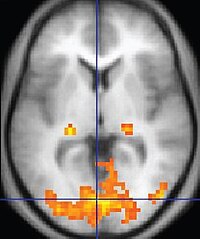
Photo from wikipedia
Objective This study aimed to study the diagnostic efficacy of positron emission tomography (PET)/magnetic resonance imaging (MRI), computed tomography (CT) and clinical metabolic parameters in predicting the histological classification of… Click to show full abstract
Objective This study aimed to study the diagnostic efficacy of positron emission tomography (PET)/magnetic resonance imaging (MRI), computed tomography (CT) and clinical metabolic parameters in predicting the histological classification of lung adenocarcinoma (ADC) and squamous cell carcinoma (SCC). Methods PET/MRI, CT and clinical metabolic data of 80 patients with lung ADC or SCC were retrospectively collected. According to the pathological results from surgery or fiberscopy, the patients were diagnosed with lung ADC (47 cases) or SCC (33 cases). All 80 patients were divided into a training group (64 cases), an internal testing group (8 cases) and an external testing group (8 cases) in the ratio of 8:1:1. Nine models were constructed by integrating features from different modalities. The Gaussian classifier was used to differentiate ADC and SCC. The prediction ability was evaluated using the receiver operating characteristic curve. The area under the curve (AUC) of the models was compared using Delong’s test. Based on the best composite model, a nomogram was established and evaluated with a calibration curve, decision curve and clinical impact curve. Results The composite model (PET/MRI + CT + Clinical) owned the highest AUC values in the training, internal testing and external testing sets, respectively. In the training set, significant differences in the AUC were found between the composite model and other models except for the PET/MRI + CT model. The calibration curves showed good consistency between the predicted output and actual disease. The decision curve analysis and clinical impact curves demonstrated that the composite model increased the clinical net benefit for predicting lung cancer subtypes. Conclusion The composite prediction model of PET/MRI + CT + Clinical better distinguished ADC from SCC pathological subtypes preoperatively and achieved clinical benefits, thus providing an accurate clinical diagnosis.
Journal Title: Frontiers in Oncology
Year Published: 2022
Link to full text (if available)
Share on Social Media: Sign Up to like & get
recommendations!